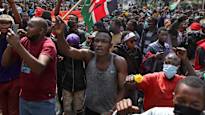In Kenya, protesters took to the streets on the anniversary of the Saba Saba protests, demanding democracy and justice. What was meant to be a day of remembrance and peaceful protest quickly turned chaotic as clashes erupted between the demonstrators and the police. The police resorted to using force, including whips and tear gas, while the protesters responded by setting fires in the streets of the capital city, Nairobi.
The scenes captured in video footage by the European Broadcasting Union (EBU) are disturbing, showing police officers striking protesters with whips and indiscriminately firing what appears to be a firearm. The violence escalated, leading to casualties on both sides. The Kenyan Human Rights Commission reported at least 10 deaths and 29 injuries across the country as a result of the demonstrations.
The Saba Saba protests have a significant historical backdrop, originating in the early 1990s as a movement demanding free and fair elections under President Daniel arap Moi’s autocratic rule. Moi had banned opposition parties in 1982, and his repressive regime faced little international scrutiny until the Saba Saba movement and subsequent pressure from Western nations forced him to liberalize the political landscape in 1991.
Over the past three and a half decades, the Saba Saba protests have evolved, now targeting President William Ruto, who stands accused of silencing opposition voices, corruption, and overseeing a police force accused of brutality. The International Criminal Court’s (ICC) attempts to investigate Ruto for stifling dissent have so far been ineffective. Recent protests have been fueled by discontent over Ruto’s administration, particularly sparked by unpopular tax hikes that brought young Kenyans to the streets.
The unrest in Kenya has claimed the lives of at least 80 protesters under murky circumstances in the past year. The mysterious death of popular blogger Albert Ojwang in police custody in June has further fueled public anger. The escalation of tensions was evident when an armed group attacked the headquarters of the Kenyan Human Rights Commission during a press conference demanding an end to state violence.
The situation in Kenya underscores the complex interplay between democratic aspirations, human rights abuses, and political power dynamics. As the country grapples with ongoing challenges to its democratic principles and governance, the international community watches closely, aware of the implications for stability in the region. The Saba Saba protests serve as a poignant reminder of the enduring struggle for democracy and justice in Kenya, reflecting broader global trends of citizens demanding accountability and transparency from their leaders.
The events unfolding in Kenya serve as a stark reminder of the fragility of democratic institutions and the importance of upholding human rights in the face of authoritarian tendencies. As the country navigates through these turbulent times, the voices of the protesters echo a resounding call for change and accountability, challenging the entrenched power structures that have long defined Kenyan politics. The legacy of the Saba Saba protests endures as a symbol of resilience and a beacon of hope for a future where democracy truly thrives.

